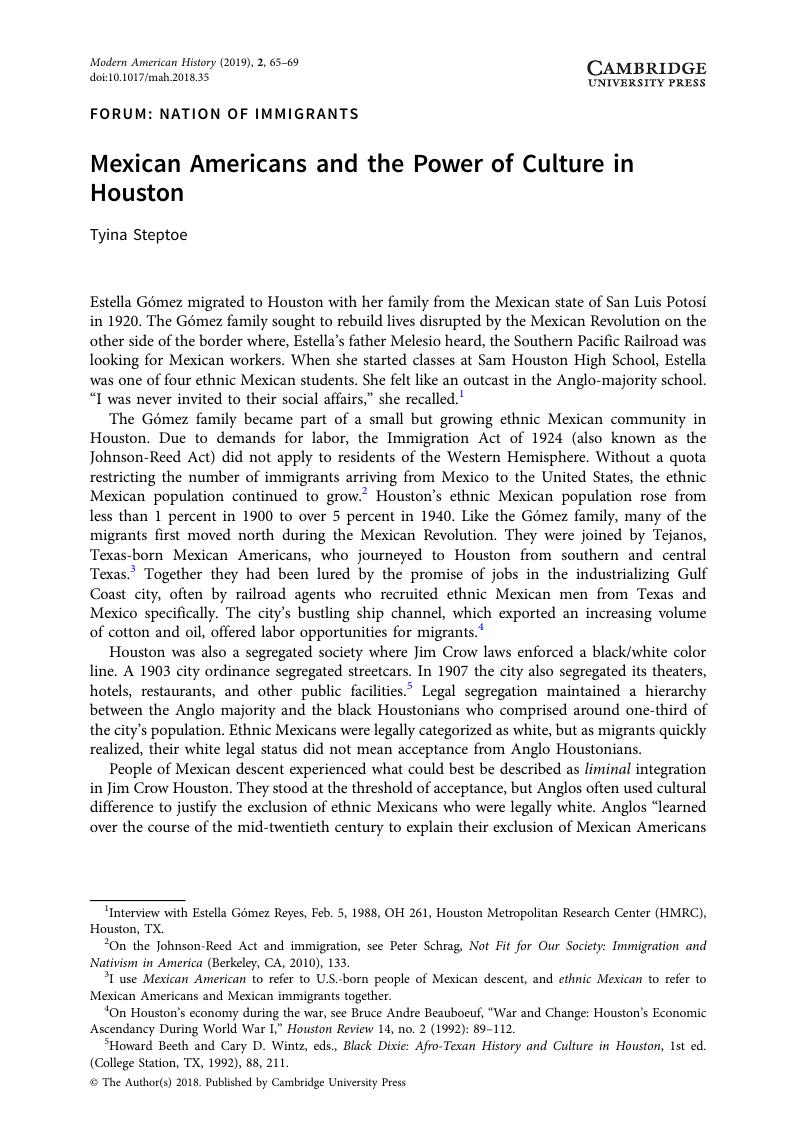No CrossRef data available.
Published online by Cambridge University Press: 20 November 2018

1 Interview with Estella Gómez Reyes, Feb. 5, 1988, OH 261, Houston Metropolitan Research Center (HMRC), Houston, TX.
2 On the Johnson-Reed Act and immigration, see Schrag, Peter, Not Fit for Our Society: Immigration and Nativism in America (Berkeley, CA, 2010), 133Google Scholar.
3 I use Mexican American to refer to U.S.-born people of Mexican descent, and ethnic Mexican to refer to Mexican Americans and Mexican immigrants together.
4 On Houston's economy during the war, see Beauboeuf, Bruce Andre, “War and Change: Houston's Economic Ascendancy During World War I,” Houston Review 14, no. 2 (1992): 89–112Google Scholar.
5 Beeth, Howard and Wintz, Cary D., eds., Black Dixie: Afro-Texan History and Culture in Houston, 1st ed. (College Station, TX, 1992), 88, 211Google Scholar.
6 Gross, Ariela, “‘The Caucasian Cloak’: Mexican Americans and the Politics of Whiteness in the Twentieth-Century Southwest,” Georgetown Law Journal 95, no. 2 (Jan. 2007): 338–92, here 342Google Scholar.
7 For a history of anti-immigrant sentiment since the Civil War, see Higham, John, Strangers in the Land: Patterns of American Nativism, 1860–1925 (New Brunswick, NJ, 1955)Google Scholar. On immigration and race, see Roediger, David R., The Wages of Whiteness: Race and the Making of the American Working Class (1991; New York, 2007)Google Scholar; Jacobson, Matthew Frye, Whiteness of a Different Color: European Immigrants and the Alchemy of Race (Cambridge, MA, 1998)Google Scholar; Guglielmo, Thomas A., White on Arrival: Italians, Race, Color, and Power in Chicago, 1890–1945 (New York, 2003)Google Scholar; Roediger, David R., Working Toward Whiteness: How America's Immigrants Became White: The Strange Journey from Ellis Island to the Suburbs (New York, 2006)Google Scholar. On Mexican Americans and whiteness, see Gross, “‘The Caucasian Cloak’”; Guglielmo, Thomas A., “Fighting for Caucasian Rights: Mexicans, Mexican Americans, and the Transnational Struggle for Civil Rights in World War II Texas,” Journal of American History 92, no. 4 (Mar. 2006): 1212–37CrossRefGoogle Scholar; Haney-López, Ian, White By Law: The Legal Construction of Race (New York, 1996)Google Scholar.
8 Houston Post, Apr. 17, 1922, 7.
9 On the connection between the Spanish language, citizenship, and power, see Lozano, Rosina, An American Language: The History of Spanish in the United States (Oakland, CA, 2018)CrossRefGoogle Scholar.
10 Houston Post, Apr. 8, 1922, 6.
11 Houston Informer, Feb. 23, 1924, 4.
12 Houston Informer, Nov. 1, 1919. For a larger discussion of black and ethnic Mexican responses to segregation in Houston, see Steptoe, Tyina, Houston Bound: Culture and Color in a Jim Crow City (Oakland, CA, 2016)Google Scholar.
13 Miguel, Guadalupe San, Brown, Not White: School Integration and the Chicano Movement in Houston, 1st ed. (College Station, TX, 2001), 23Google Scholar.
14 San Miguel, Brown, Not White, 28–30.
15 Catalina Gómez Sandoval interviewed by Tom Kreneck and Emma Pérez, Feb. 3, 1989, OH 377, HMRC, Houston, TX. In response to the growing number of ethnic Mexican students in the Magnolia Park neighborhood, the school district built a new school there in 1920. School officials did not formally mark Lorenzo de Zavala Elementary as a segregated school for ethnic Mexican children, but it existed because of concerns over the high number of Spanish-speaking students attending the two white schools in the area. San Miguel, Brown, Not White, 21.
16 The segregation of Mexican Americans in public schools did not occur uniformly. For example, the Denver school district never formally segregated its public schools; however, school officials enacted practices that created racially segregated schools for Mexican-American and black students. Historian Danielle Olden writes, “These practices included selecting school building sites, gerrymandering attendance boundaries, and busing students to ensure as little racial mixing as possible between Anglo and other students.” As a result, Denver was home to schools that were majority Anglo, majority black, and majority Mexican American, though some schools were black and Mexican American. Even within Texas, different patterns of segregation emerged. By the early 1940s, at least 122 school districts in fifty-nine Texas counties had separate schools for Mexican American students. See Olden, Danielle, “Becoming Minority: Mexican Americans, Race, and the Legal Struggle for Educational Equity in Denver, Colorado,” The Western Historical Quarterly 48 (Spring 2017): 44CrossRefGoogle Scholar; Montejano, David, Anglos and Mexicans in the Making of Texas, 1836–1986 (Austin, TX, 1987), 4–5, 160–1Google Scholar. See also Behnken, Brian, Fighting Their Own Battles: Mexican Americans, African Americans, and the Struggle for Civil Rights in Texas (Chapel Hill, NC, 2011)CrossRefGoogle Scholar; Miguel, Guadalupe San, Chicana/o Struggles for Education: Activism in the Community (College Station, TX, 2013)Google Scholar.
17 Carmen Cortés interviewed by Tom Kreneck, Dec. 16, 1983, OH 313, HMRC, Houston, TX; interview with Carmen Cortés, May 2, 1989, OH 313, HMRC, Houston, TX. On the formation of the club, see also Pérez, Emma, The Decolonial Imaginary: Writing Chicanas into History (Bloomington, IN, 1999)Google Scholar. On Catholicism in Houston's ethnic Mexican communities, see Treviño, Roberto R., The Church in the Barrio: Mexican American Ethno-Catholicism in Houston (Chapel Hill, NC, 2006)Google Scholar.
18 Hardin, Sid L., “The Glory of American Citizenship,” LULAC News 2, no.4 (Dec. 1932): 3Google Scholar.
19 Interview with Janie (Gonzales) Tijerina, Oct. 16, 1978, OH 234, HMRC, Houston, TX.
20 Kreneck, Thomas H., Mexican American Odyssey: Felix Tijerina, Entrepreneur and Civic Leaders, 1905–1965 (College Station, TX, 2001), 53; 62-3Google Scholar.
21 F. Kenneth Jensen, “The Houston Sit-In Movement of 1960–61,” in Black Dixie, 217; Kreneck, Mexican-American Odyssey, 261–2.
22 Carmen Cortés interviewed by Tom Kreneck, December 16, 1983, OH 313, HMRC, Houston, TX; interview with Estella Gómez Reyes Feb. 5, 1988, OH 261, HMRC, Houston, TX.
23 The undated article can be found in a 1930s scrapbook in the Melesio Gómez Family Collection, Folder 18, Box 1, MSS 135, HMRC, Houston, TX.
24 See also Elliott Young's study of celebrations and pageants in Laredo, Texas, at the turn of the twentieth century: Young, Elliott, “Red Men, Pocahontas, and George Washington: Harmonizing Race Relations in Laredo at the Turn of the Century,” Western Historical Quarterly 29, no. 1 (Spring 1998): 48–85CrossRefGoogle Scholar.